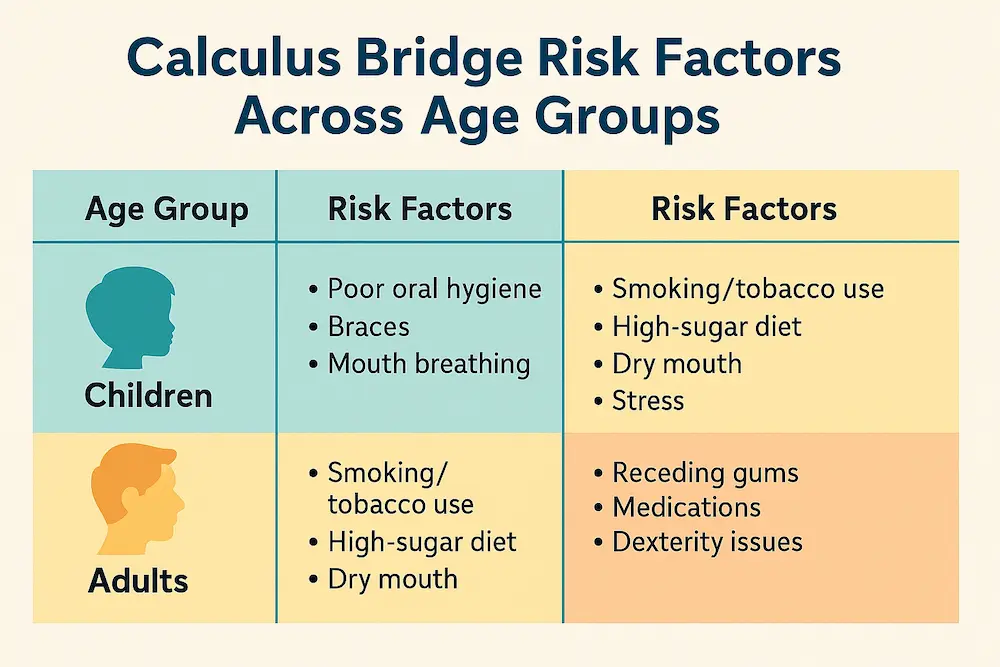Have you ever noticed a dark, crusty line along your gumline that seems to connect multiple teeth? This "crusty looking" formation could be a calculus bridge, one of the most concerning forms of tartar buildup that can seriously threaten your oral health. Many patients discover these hardened deposits during routine dental visits, often shocked to learn they've been developing for months or years without their knowledge.
A calculus bridge represents more than just a cosmetic concern. This mineralized plaque formation can harbor dangerous bacteria, cause gum disease, and lead to tooth loss if left untreated. Understanding what causes these formations and how to prevent them is crucial for maintaining long-term oral health and avoiding costly dental complications.
What Is a Calculus Bridge
A calculus bridge is a hard, crusty layer of tartar (mineralized plaque) that spans across multiple teeth, typically forming along the gumline. It develops when sticky dental plaque is not cleaned off and hardens on the tooth surface over time. These deposits can merge between teeth to form a continuous "bridge" of calcified material.
The term "bridge" refers to how tartar literally spans or connects across several teeth. Early on, calculus may appear as isolated patches on individual teeth. As it grows, these patches connect and merge with deposits on neighboring teeth, forming a solid band that bridges across multiple teeth like a dental bridge structure.
Appearance and Visual Characteristics
A calculus bridge typically appears as yellowish, tan, brown, or even black deposits near the gumline. The formation creates a rough, dark border connecting adjacent teeth. Above the gums, calculus often has a yellow or tan color, while beneath the gums, it appears darker: brown, black, or even greenish.
The darker colors develop as the calculus easily absorbs stains from coffee, tea, or smoking. Over time, the bridge becomes more noticeable and creates a continuous band of discoloration along the gumline, filling the spaces between teeth with hardened deposits.
How Calculus Bridges Form
Plaque is a thin, sticky film of bacteria that constantly forms on our teeth after eating. If plaque is not removed daily, minerals in your saliva cause it to harden into calculus (tartar). Studies show plaque can begin to calcify in as little as 1-2 weeks. As more plaque accumulates, the tartar layer grows, often forming in hard-to-brush spots like the gumline and between teeth.
The Mineralization Process
The transformation from soft plaque to hard calculus happens through mineralization. Calcium and phosphate ions from saliva are deposited into the plaque matrix, gradually hardening the bacterial film. This process is irreversible once it begins, which is why prevention through daily oral hygiene is critical.
The speed of mineralization varies among individuals due to factors like saliva composition, pH levels, and the types of bacteria present in the mouth. Some people naturally produce saliva with higher mineral content, making them more prone to rapid calculus formation.
Progressive Bridge Development
The bridge structure creates an environment where bacteria can thrive, protected from normal cleaning efforts. This bacterial haven continues to grow and spread, making the bridge progressively larger and more difficult to manage without professional intervention. As deposits from adjacent teeth merge, they form the characteristic "bridge" appearance that gives this condition its name.
Risk Factors and Who's Most Affected
Everyone produces plaque, but certain factors accelerate calculus formation and increase the risk of developing bridges:
Primary Risk Factors
- Poor oral hygiene: Infrequent or inadequate brushing and flossing allows plaque to harden
- Smoking and tobacco use: Tobacco users develop thicker, darker calculus more rapidly
- Dry mouth: Medications or conditions that reduce saliva accelerate tartar buildup
- High-sugar diet: Provides fuel for bacteria that contribute to calculus formation
- Age factors: People over 65 face increased risk due to cumulative buildup
- Genetics: Family history of gum disease or heavy tartar formation increases susceptibility
Age-Specific Considerations
Children and Teenagers: Young children usually have less tartar because baby teeth are replaced frequently and oral care is often supervised by parents. However, teens with braces face unique challenges as orthodontic hardware creates numerous hiding places for plaque. Without meticulous cleaning around brackets and wires, calculus bridges can develop that are particularly difficult to remove.
Adults: By adulthood, people have had more time for plaque accumulation. Busy schedules, stress, and lifestyle habits like coffee consumption, wine drinking, and smoking can accelerate buildup. Adults who use tobacco products or take medications causing dry mouth see calculus bridges forming faster.
Seniors: Older adults tend to have the heaviest calculus bridges due to years of accumulation, receding gums, and age-related dry mouth. Many seniors take medications that reduce saliva or have decreased manual dexterity, making thorough cleaning more challenging.

Risk factors for calculus bridge development across different age groups
Health Dangers and Complications
A calculus bridge poses serious health risks beyond cosmetic concerns. The bacterial-packed tartar creates multiple threats to oral and overall health:
Immediate Oral Health Effects
Gum Disease Development: Calculus irritates and inflames the gums, leading to red, swollen gums that bleed easily (gingivitis). The bacteria in calculus bridges produce toxins that directly damage gum tissue. As the immune system responds to this bacterial threat, inflammation increases, potentially progressing to periodontitis where infection spreads deeper.
Bad Breath (Halitosis): The bacteria trapped in tartar produce foul odors, causing chronic bad breath that doesn't improve with regular brushing or mouthwash.
Increased Cavity Risk: Calculus provides a rough surface where additional plaque can hide. Under this protective shell, acid-producing bacteria continuously attack tooth enamel, significantly raising the risk of decay and cavities in hard-to-clean areas.
Serious Long Term Consequences
Tooth Loss: Advanced gum disease from unchecked tartar can destroy the bone and ligaments holding teeth. As periodontal disease progresses, it destroys supporting structures including the periodontal ligament and alveolar bone. This destruction is often irreversible, eventually causing teeth to loosen and fall out.
Systemic Health Effects: Severe gum infections have been linked to serious health issues. Chronic periodontal inflammation is associated with higher risks of heart disease, stroke, and complications in diabetes. Researchers believe the chronic inflammation and bacteria can affect the entire body through the bloodstream.

Expert Insights and Professional Perspectives
Dental experts universally emphasize that calculus bridges cannot be removed through home care. According to Healthline, once you have a bridge of calcified plaque on your teeth, you cannot brush it off. A dentist or dental hygienist must remove it professionally.
This aligns with American Dental Association guidance: plaque left on teeth hardens into tartar, and once tartar is present, "only professional cleaning" can remove it.
Clinical Evidence
Delta Dental's chief dental officer, Dr. Joseph Dill, explains that a calculus bridge is literally "the calculus around individual teeth that join to form a solid 'bridge' around several teeth." He warns that the bridge will only worsen with time, becoming "more noticeable the longer it goes untreated."
Research consistently shows that attempting to remove calculus at home can damage tooth enamel and gum tissue while leaving bacterial deposits intact. Professional scaling instruments are specifically designed to remove hardened deposits safely without harming surrounding structures.
Professional Treatment Options
Removing a calculus bridge requires professional dental care. Treatment progresses from basic to advanced approaches based on severity:
Basic Professional Cleaning
Scaling and Polishing: The hygienist uses hand scalers or ultrasonic tools to scrape off all visible tartar from above the gumline. Hand scaling involves specially designed instruments to carefully remove calculus deposits, requiring skill and experience to avoid damaging tooth enamel or gum tissue. Polishing follows to smooth tooth surfaces so new plaque doesn't stick as easily.
Advanced Cleaning Techniques
Ultrasonic Scaling: For tough tartar, dentists use ultrasonic scalers with tips that oscillate rapidly, chipping away hardened deposits while spraying water to wash debris away. This method is particularly effective for heavy calculus deposits and often more comfortable than traditional hand scaling alone.
Root Planing: If the bridge extends below the gums, deeper cleaning called root planing is performed. The dentist numbs the area and scrapes off subgingival calculus from tooth roots. This procedure often requires local anesthesia and may be completed over multiple appointments.
Surgical Interventions
Advanced Periodontal Therapy: In severe cases with bone loss, a gum specialist may perform surgery including pocket reduction or osseous surgery to reshape bone. Laser or antibiotic therapies may also be used to eliminate bacteria under the gums and create conditions for healing.

Comprehensive Prevention Strategy
Preventing calculus bridges requires a multi-faceted approach focusing on stopping plaque before it hardens:
Essential Daily Habits
Proper Brushing Technique: Use a soft-bristled toothbrush and fluoride toothpaste to brush all tooth surfaces for 2 minutes, focusing especially on the gumline where calculus bridges typically form. Use gentle circular motions rather than aggressive scrubbing. Electric toothbrushes can be particularly effective at removing plaque from difficult-to-reach areas.
Daily Flossing: Clean between teeth with floss or interdental brushes to remove plaque missed by brushing. This step is crucial for preventing calculus formation in the spaces between teeth where bridges commonly develop.
Antibacterial Rinse: Use an ADA-approved antibacterial mouthwash once or twice daily to help kill bacteria and wash out food particles, especially important for smokers or those prone to heavy plaque buildup.
Lifestyle Modifications
Dietary Considerations: Limit sugary snacks and drinks that feed plaque bacteria, accelerating the mineralization process. Include crunchy fruits and vegetables that help mechanically clean teeth and stimulate saliva production.
Tobacco Cessation: Quitting smoking or chewing tobacco drastically reduces calculus buildup. The chemicals in tobacco products create an environment promoting bacterial growth and rapid calculus formation. Within weeks of quitting, patients often notice reduced plaque formation and improved gum health.
Stay Hydrated: Adequate water intake helps maintain saliva production, which naturally helps wash away food particles and bacteria.
Professional Maintenance
Regular Dental Visits: Even with excellent home care, plaque can harden in hidden spots. Standard cleanings every 6 months are essential, though those prone to heavy calculus buildup may need professional cleanings every 3-4 months.
Customized Prevention Plans: Your dental team can assess individual risk factors and recommend appropriate maintenance schedules and specific home care techniques.
What to Expect During Treatment
Visit a dentist if you notice symptoms like persistent bad breath, gum bleeding, or visible tartar. During your dental checkup:
Assessment and Diagnosis
The dentist or hygienist will examine your mouth, looking for signs of calculus bridges and using a probe to check gum pockets. The examination includes visual inspection, tactile exploration with dental instruments, and often X-rays to assess bone levels and hidden calculus deposits.
Treatment Process
Professional cleaning usually starts with scaling off all tartar on and below the gums. The cleaning process is tailored to each patient's specific needs - some require only routine scaling, while others need deep cleaning procedures performed over multiple appointments.
Post-Treatment Care
After removal, teeth are polished and you may receive a fluoride treatment. Some gum tenderness or tooth sensitivity for a day or two after cleaning is normal since the protective tartar layer is gone. Post-treatment sensitivity occurs because removing calculus exposes tooth surfaces that have been covered for extended periods.
Long-Term Management
Successfully preventing calculus bridge recurrence requires ongoing commitment to oral health maintenance. Consistency in oral hygiene practices is more important than perfection. Focus on establishing sustainable routines rather than attempting dramatic changes that may be difficult to maintain.
Your dental care team has the expertise to identify early calculus formation and remove it before bridges develop. Regular professional cleanings also provide opportunities to refine home care techniques and address any changes in oral health status.
If you suspect calculus bridge formation or want to discuss prevention strategies, contact our dental team to schedule a comprehensive evaluation. Early intervention and consistent prevention efforts provide the best outcomes for long-term oral health.
Maintaining excellent oral health through proper home care and regular professional cleanings is your best defense against calculus bridges and their associated health risks. With the right approach and commitment to prevention, you can keep your smile healthy and avoid the serious complications that calculus bridges can cause.





